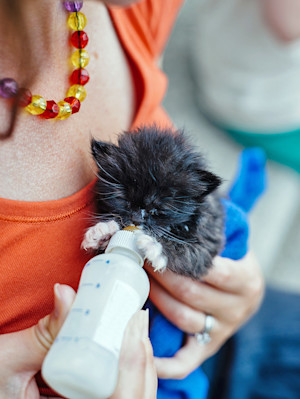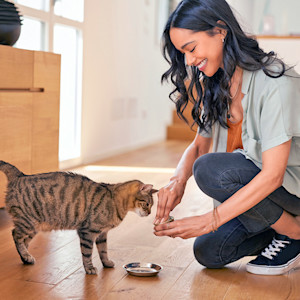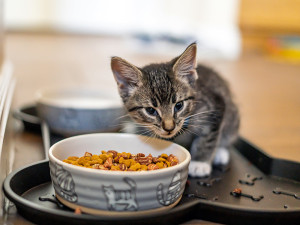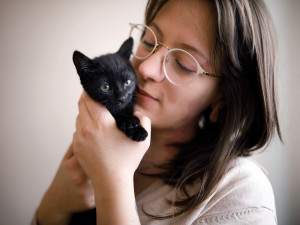How to Help a Kitten Poop: Step-by-Step Guide for New Pet Parents
Someone’s gotta do it.
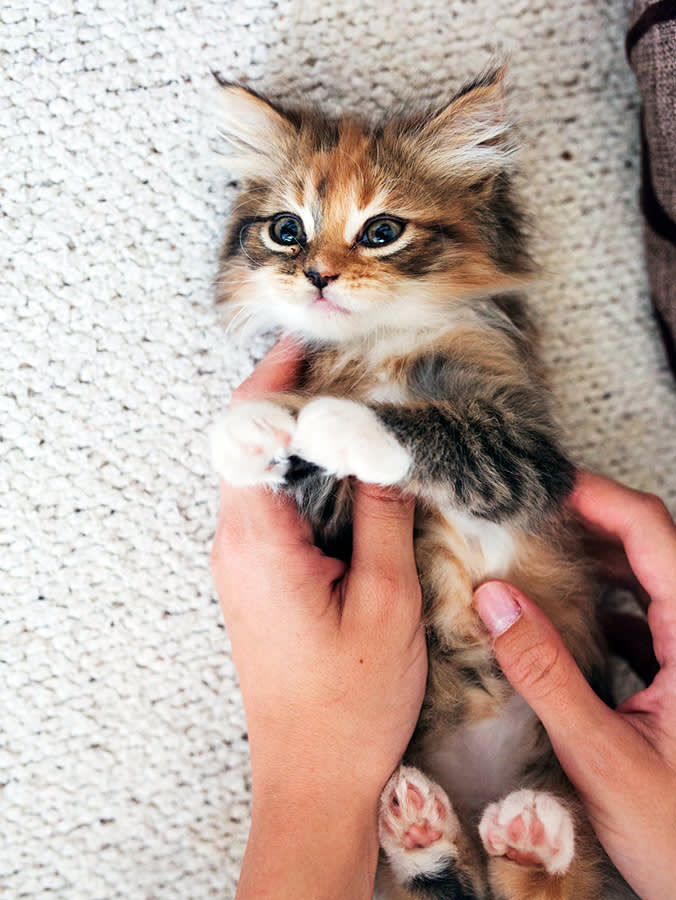
Share Article
In This Article:
Why Kittens Need Help to Poop Signs Your Kitten Needs Assistance How to Stimulate a Kitten to Poop: Step-by-Step Guide Risks of Not Stimulating Elimination Tips for Avoiding Constipation in Kittens
Did you know that newborn kittens cannot pee or poop on their own without help from their mamas? This is important to understand if you find yourself caring for newborn kittens that are separated from their moms before 4 weeks of age. They will need round-the-clock care including frequent feedings and stimulation to pee and poop.
Read on to learn more about this process in kittens including step-by-step techniques and tips to support your newborn kitten’s development, health, and wellbeing.
How much do you spend on your pet per year?

Why kittens need help to poop
When kittens are first born, they are pretty helpless and rely on their moms for everything, including temperature regulation, food, cleaning, and stimulation to pee and poop. Newborn kittens are altricial, which means they are born in an immature state of development and lack the coordinated muscle control and nervous system function needed to pee and poop on their own, along with many other tasks.
When they are first born, their eyes and ears are also closed so they use their sense of smell to stay close to their moms. They need their moms to carry them around and use her body as a heat source to stay warm. Mama cats are busy round-the-clock nursing and cleaning their kittens. They use their tongues to stimulate the babies to pee and poop frequently throughout the day and keep the nest area clean.
In the first few weeks of life, kittens develop rapidly, with their eyes and ears opening within the first two weeks. Similarly, they develop control over the process of peeing and pooping between three and four weeks old. If you are caring for an orphaned kitten who is less than four weeks old, you’ll want to be sure to keep up with all the kitten’s needs, including stimulating them to pee and poop. If you are finding that your kitten is not peeing and pooping regularly even with stimulation, there may be some issues you need to trouble-shoot, including:
Inadequate stimulation: Be sure you know the proper technique to stimulate kittens to pee and poop and that you are stimulating them frequently throughout the day and night. If you feel like you’re not quite getting it, have a veterinary professional demonstrate for you.
Poor hydration: If your kitten is not getting enough milk, they may be at risk for dehydration, which can reduce their need to pee and poop. Based on your kitten’s age and weight, you’ll need to follow specific feeding guidelines. Be sure you weigh your kitten daily using a kitchen scale that measures their weight in grams to keep track of subtle gains or losses.
Imbalanced diet: Newborn kittens need to have an appropriate diet in order to grow, thrive, and have healthy digestion. The best option is for them to nurse directly from a mother cat. For orphaned kittens, it is critical that they consume a balanced kitten milk-replacement formula that will provide them with appropriate nutrition. Feeding kittens cow’s milk or other dairy products is not healthy for them and can cause serious digestive problems along with nutritional deficiencies and even death.
Digestive problems: Newborn kittens may suffer from digestive problems that affect their ability to poop normally. This can include infectious diseases like parasites and bacterial infections as well as congenital problems with their digestive tract. Be sure to see a vet if your kitten does not seem to be peeing and pooping on a regular schedule or seems to have difficulty eliminating.
Signs your kitten needs assistance
Newborn kittens are very fragile so the sooner you can identify a problem, the better chance your kitten will have for recovering. To help catch problems as early as possible, it is a good idea to monitor your kitten’s general health parameters daily.
Keep a log of their daily weights, how many milliliters of formula they drink at each feeding, and record any time they pee or poop throughout the day after stimulation. This will help you notice red flags, such as weight loss, decreased appetite, or infrequent bowel movements before your kitten is in a crisis. Additional signs to look for include:
Decreased appetite: Kittens may refuse to eat or eat less than usual if they need to poop, creating a feeling of pressure in their bellies. You may want to get into the habit of stimulating your kitten to pee and poop before and after eating to increase the likelihood that they will be comfortable and eat well. If your kitten is refusing a feeding or does not eat with gusto, try stimulating them to pee and poop and then offer food again a few minutes later.
Swollen belly or bloating: If you can see that your kitten’s belly is visibly swollen, try to stimulate them to pee and poop as this may be the reason for their bloated appearance.
Straining or crying after meals: All kittens should be stimulated to pee and poop after eating, but if you notice that your kitten still seems uncomfortable shortly after eating, try to stimulate them again.
Lack of bowel movements for over 24 hours: This is where it is very helpful to keep good records of your kitten’s routine. It can be difficult to remember from day to day when your kitten last pooped, especially if you are sleep-deprived from overnight feedings and round the clock kitten care. Keep a close eye on a kitten that has not pooped in 24 hours and contact your vet if they go any longer than that.
Visible agitation or discomfort: If your kitten is more restless than usual, meowing a lot, or showing other signs of agitation, it’s worth a try to stimulate them to pee and poop. There could be many other possible causes for this behavior, but it’s an easy fix if they just needed to be stimulated again.
How to help a kitten to poop: step-by-step guide
If you have never cared for a newborn kitten and stimulated them to pee and poop, it is a good idea to have a professional show you how to do it at first. Remember to stick to a routine based on your kitten’s age and weight, as far as how often to feed them and how much to feed them. Part of that routine should be to stimulate them to pee and poop before and after each feeding, as well as other times as needed. Some general guidelines on how to stimulate kittens include:
Gather supplies: you’ll need cotton balls and warm water to stimulate your kitten. You’ll also want to be ready with a pee pad or other absorbable surface that can catch the pee and poop.
Position the kitten: Hold your kitten in their normal upright position with their paws and belly facing down. You may need to lift their tail in order to access their perineal region, which is where their genitals and anus are located.
Stimulate gently: It is worth emphasizing that this needs to be done very gently; this is a delicate area and will have to be stimulated multiple times a day. It is easy for the skin to become irritated from excessive pressure or friction, so try to use the least amount of pressure possible. Gently dab and wipe the perineal area and their surrounding belly with a cotton ball moistened with warm water. If you don’t see any pee or poop, you can also try to run a light stream of warm water over the area. Be sure to always check that the water temperature isn’t too hot to burn their skin and make sure your kitten is dry and warm after each session.
Observe and record results: You may not have planned on studying your kitten’s pee and poop on the daily, but it is an important clue to their overall health. Note whether their urine looks dark yellow, which can indicate dehydration, versus light yellow or clear. Also pay attention to any abnormal colors in their poop or changes in the consistency of their poop. Keep a record of every time they pee and poop as well as any abnormal findings.
Hygiene matters: Newborn kittens have immature immune systems and are more susceptible to infections. Be sure to maintain a clean, dry environment by using fresh water and new supplies each time. Wash your hands before handling your kitten and after you stimulate them to pee and poop. If any urine or poop gets on your kitten, be sure to clean them off and to make sure their nest box is always kept clean, dry, and warm.
Risks and complications
Severe constipation
Kittens who are not stimulated to poop regularly can be at risk for severe constipation. This is painful and can also cause a decreased appetite, slower growth, dehydration, and life-threatening complications.
Abdominal pain or bloating
Kittens who need to poop feel bloated and uncomfortable and may experience distress as well as a decreased appetite.
Skin irritation
Even though we do our best to mimic how a mother cat cares for her kittens, the gentlest cotton balls are not a perfect substitute for the way a mother cat can groom and stimulate her kittens to poop. Many kittens will develop irritation around their genitals and anus from the frequent stimulation required to help them pee and poop. Be sure to monitor closely for any redness or swelling and contact your vet right away if you notice signs of skin irritation.
Tips for avoiding constipation in kittens
Newborn kittens may experience constipation for a number of reasons. You can avoid some common pitfall through these tips:
Provide sufficient hydration: Make sure your kitten is eating frequently enough and getting an appropriate amount of food at each feeding. Kittens who are being bottle-fed do not need a separate water source. You can get a sense of your kitten’s hydration by the color of their urine; dark urine is a sign they may be dehydrated and you may need to add some additional water to each feeding so be sure to consult with a vet.
Avoid overfeeding: Some kittens are very enthusiastic eaters, but you’ll want to try to stick to the guidelines for how much to feed them based on their age and weight. Overfeeding can sometimes lead to constipation as well.
Feed a proper diet: Orphaned kittens who need to be bottle-fed must drink a kitten milk replacer that is designed specifically for nursing kittens. Feeding other kinds of formula, cow’s milk, or homemade recipes puts kittens at risk for constipation as well as nutritional deficiencies, poor growth, and life-threatening complications.
Prevent ingestion of non-food items: Be sure your kittens don’t have access to any small, non-food items they may accidentally eat as this can cause constipation or more serious intestinal blockages. A common mistake is for newborn kittens to have access to a litter box with clumping litter or other small particles that they may accidentally ingest, leading to constipation. Kittens that are still being stimulated to pee and poop don’t really need a litter box at all, but you can line a box with paper or a pee pad if you want to expose them to it as they get older.
Bottom line
Stimulating newborn kittens to pee and poop is a critical part of their round-the-clock care routine.
Be sure you learn the proper technique to stimulate your kitten to pee and poop and to avoid common complications.
If your kitten doesn't poop in 24 hours and/or has a decrease in appetite or loses weight, be sure to see a vet right away.
References
Davidson, A, et al, “Management of the Neonate in Dogs and Catsopens in new tab,” Merck Veterinary Manual, Modified April 2025.
“Understanding the causes and treatment for constipation in kittensopens in new tab.” The National Kitten Coalition, 6 June 2023.
Veronesi, M, et al, “Feline neonatology: From birth to commencement of weaning – what to know for successful managementopens in new tab.” Journal of Feline Medicine and Surgery, 25 February 2022, vol. 24, no. 3, pp. 232-242.

Dr. Amy Fox, DVM
Amy Fox, DVM is a small animal veterinarian in New York City with over thirteen years of experience in a mixture of general practice, emergency medicine, and shelter medicine. A lifelong animal lover, Dr. Fox studied biology in college and then worked as a veterinary nurse before pursuing veterinary school at Cornell University. Her expertise includes surgery, dentistry, and management of chronic conditions, and she is interested in toxicology, pain management, nutrition, care of senior pets, and educational outreach. Dr. Fox also enjoys writing about veterinary medicine and teaching, and her work has previously appeared in Spruce Pets. In her free time, she loves to cook, garden, go for long runs, and hang out with her goofy mixed-breed dog May, who provides never ending comic relief!
Related articles
![Woman bottle feeding kitten.]()
How to Bottle-Feed a Kitten
Starting with the supplies you’ll need.
Can You Give a Kitten Milk?
It depends on what kind.
![Woman feeding her kitten.]()
When Can a Kitten Eat Wet Food?
And how to know what kind they need.
![Kitten eating dry food from a bowl.]()
Can a Kitten Eat Dry Food?
And the nutrients you should make sure they’re getting.
![Relaxed girl holding a black kitten near her face.]()
What to Expect When Fostering a Kitten
Besides plenty of cuteness, of course.
![A hand holding a kitten with a cat tattooed at the hand.]()
Heads Up: It’s Officially “Kitten Season”
Hannah Shaw, aka Kitten Lady, on how you can care for orphaned kittens this spring.
What Can I Feed a Kitten?
Learn what nutrients are a must for your new little one.



